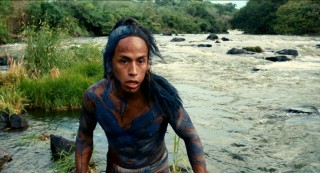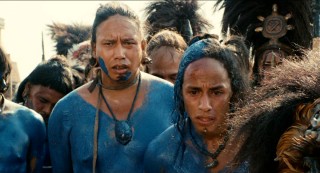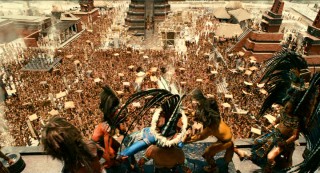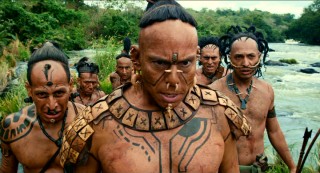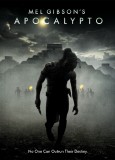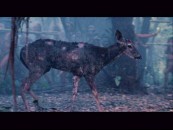![]()
Apocalypto DVD Review
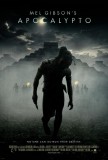 |
Apocalypto
Theatrical Release: December 8, 2006 / Running Time: 138 Minutes / Rating: R Director: Mel Gibson / Writers: Mel Gibson, Farhad Safinia Cast: Rudy Youngblood (Jaguar Paw), Jonathan Brewer (Blunted), Morris Birdyellowhead (Flint Sky), Raoul Trujillo (Zero Wolf), Gerardo Taracena (Middle Eye), Dalia Hernandez (Seven), Isabel Diaz (Mother in Law), Rodolfo Palacios (Snake Ink), Carlos Emilio Baez (Turtles Run), Amilcar Ramirez (Curl Nose), Israel Contreras (Smoke Frog), Ariel Galvan (Hanging Moss), Fernando Hernandez (High Priest), Maria Isidra Hoil (Oracle Girl), Aquetzali Garcia (Oracle Girl) |
Buy DVD from Amazon.com Buy Blu-ray from Amazon.com
Hollywood has a short memory. Thus, when the fourth and latest directorial effort by Mel Gibson was released to theaters, most people thought not of Gibson's past as an Australian-accented sex symbol of the '80s, as a bona fide action movie star, or as the helmer of the multi-Oscar-decorated Braveheart. They thought of The Passion of the Christ, the unprecedented 2004 blockbuster he directed and co-wrote, and they thought of his summer 2006 arrest in Malibu on suspicion of drunk driving, during which he is reported to have uttered some prejudiced, profane remarks.
The first connection was inevitable, not only because The Passion was Gibson's previous film but because like it, Apocalypto was unconventionally set in an ancient, foreign world and brought to life in a language unfamiliar to most of living mankind. The arrest was in people's minds purely due to timing, as it occurred while Gibson was still at work on Apocalypto, a mere four months before the project's unaffected opening. The mix of a controversial high and a much-publicized low surely worked to Apocalypto's favor financially. Apocalypto opens in a prosperous patch of rainforest among Mexico's Yucatαn Peninsula. It is, one later discovers, around the turn of the 16th century, though there is little of the progress (and none of the wardrobe) to cue those not well-versed on the Mayan Empire as to the time period. The central village has been passed down from generation to generation and is currently ruled by Flint Sky (Morris Birdyellowhead), a wise, proud, defensive individual. The few other villagers we meet also fit modern Western archetypes. There is Blunted (Jonathan Brewer), a target of ridicules who has a pushy mother-in-law (Isabel Diaz) that demands grandchildren. This sympathetic husband initially seems like he'll be our protagonist, but in fact that honor goes to Jaguar Paw (Rudy Youngblood), Flint Sky's headstrong son who is nonetheless plagued by fear of outside attack.
In the film's opening scene, a boar-ish tapir is violently impaled by a spiked trap, setting the tone for what is to come: this is most gruesomely graphic film I've ever seen. Not long after the village life and order is established on screen, Jaguar Paw's fears come true when savage outsiders known as the Holcane Warriors invade at dawn, slaughtering and terrorizing sleeping families with an assortment of weapons and little restraint. It's unclear if there's a method to the madness, but this chaotic massacre is only the beginning of intense mayhem. When the bloody dust has settled, Jaguar Paw is among dozens of bound captives after witnessing (and perhaps causing) his father's execution via throat-slicing. Jaguar Paw's wife (Dalia Hernandez), who's well along in her latest pregnancy, is left alone with their very young son in a deep, waterless well (a chultun, which the Maya built as underground storage centers). The mother and son's relocation effectively ensures them protection but also traps them without food, comfort, or any idea what's going on above. Nevertheless, before he is captured, Jaguar Paw promises to return to his young family.
What ensues next is vast bloodshed, extreme gore, and violence that I'm somewhat shocked flew past the MPAA's radars with an "R" rating that didn't even require an appeal. Those of us made uneasy by the graphic torture afflicted in The Passion of the Christ could justify it because, according to Gibson's well-known religious convictions, it was a true story and one which the director wanted to emphasize the Christian Messiah's suffering in retelling. There's far less to excuse the wince-inducing acts that occur in this utterly fictional screenplay, which Gibson co-wrote with Farhad Safinia.
Some anthropology professors criticized Gibson for what they claim is an historically inaccurate portrayal of Mayan society as brutal. Deciding whether or not that's a fair argument would require more research than any single review should merit, so I'll go no further with that. Besides, with no outstanding interest in ancient cultures (a trait I'm sure I share with a majority of Apocalypto's audience) and an understanding that Gibson is a known stickler for authenticity, my only concern for this would be in fair, researched portrayal (something regularly violated in Hollywood). Plus, I'm not entirely convinced those finding fault and shouting "racism" aren't looking to further themselves and their work by flocking to one of controversy's greatest contemporary magnets and making headlines in the process.
Getting back to the film itself, Jaguar Paw and his fellow prisoners (which include Blunted, his mother-in-law, and a caution-bearing refugee, among many others) are subjected to a demanding trek. After enduring falling trees and off-cliff-pushing, That's what the filmmakers want, for the movie turns into a vengeance-fueled cat and mouse when Jaguar Paw, beating tremendous odds, manages to escape his impending death. So vile are the Holcane that even when it appears they won't need any more subjects for public sacrifice (due to a convenient solar eclipse), they still plan on murdering the captives and making a sport out of it, no less. When Jaguar slips off, a ruthless pack of Holcane follow him. The good vs. evil chase through a treacherous natural obstacle course raises questions of credibility. How small and well-known is this jungle for a group to keep spotting their target? Why do the baddies value punishing one renegade over their own livelihoods? Apocalypto only makes a mild effort to address such issues of logic, as it instead opts to run on adrenaline.
With all the off-putting plot elements and visuals, the movie still managed to keep me engaged. That's because Gibson and company clearly know how to frame an action film. It's a manipulative process with the obligatory sympathy (pregnant wife and child need to be rescued) justifying anything and gripping viewers to long for and expect a happy ending reunion while still fearing it could be taken away at any given moment. Apocalypto is all about merging modern-day cinema sensibilities with its ancient, primitive world. It's not unlike Gladiator or Braveheart in that way. Themes -- sex, violence, family loyalties -- are as in style today as ever. There's even a bit of spirituality which, despite the different vocabulary, speaks clearly to modern audiences of faith. The result is that for all the tools in its highly unusual palette -- ancient Mayan language, a cast void of Caucasians and celebrities, tiny wardrobes, expressive body art far more severe than today's tattoos -- Apocalypto is fairly predictable and conventional, like a lesser Die Hard transposed to Mexico and wound back 500 years. The result is an exciting roller coaster ride that's poignant in a few places and unique in some ways, but still fairly shallow and unexceptional in the end.
I'd be lying if I didn't admit that the graphic nature of Apocalypto contributes to my tepid response. Dramatically, the film would be just as effective (if not more so) resorting to implication at times instead of depicting so much vivid bloodshed. Were the movie tailored to moviemaking norms and designed for a PG-13 rating, the impact of the terrible villainy might be lessened. (Then again, look at the plenty disturbing PG-rated Indiana Jones and the Temple of Doom which dealt with some similar imagery 23 years ago.) Such a rant may lead you to expect that I've written off this film altogether, but I can't do that so easily. For one thing, Apocalypto's intentions to immerse modern moviegoers in a forgotten foreign world seem noble. They're decently realized too, as the use of Mayan language lends an air of authenticity to the proceedings without making the movie hard to bear (its shock value takes care of that). Most of the second half of the film is free of dialogue (or a need therefore), and while some may consider an American filmmaker opting for subtitles pretentious or indulgent, it makes sense here, as it did for Passion, to distinguish the film from the type that rely on accented English and stiff speech to indicate foreign and ancient peoples, respectively. The convincing realism is further enforced by a cast of inexperienced actors, predominantly rounded up from Central America, who turn in a number of impressive performances without the baggage of recognition. Still, the apparent push for historical accuracy falls apart when one realizes the film is more concerned with ancient torture practices and rituals than it is with the Mayan culture, lifestyles, or achievements.
Shot in Catemaco and Veracruz, Apocalypto is nicely-photographed by Dean Semler, who uses mobile digital video cameras to capture the action. Of course, the visuals are marred by the level and extent of horrific images. They also clash with some of the oddities of subjects filmed. Seen in passing moments among the crowds: stumps, a little ball-like man carried around on a plate, an extra-skinny man with the "laughing sickness", and similarly malnourished individuals. Naturally, even the heroes have a different look to them than traditional action protagonists, with their strange piercings, earlobe stretchings, face beads, and body art. Still, the villains are distinguished by even stranger designs and attire; many are face-tattooed. VIDEO and AUDIO
Apocalypto is presented in a solid 1.85:1 anamorphic widescreen transfer. Digital video is an unlikely medium for a period epic of this sort, but it is high-grade and only sometimes evident (in blurring) that traditional film was not used. Gibson praises the camera technology, known as Genesis, throughout the commentary, so he's pleased with the way his film looks. As far as the DVD is concerned, nothing stood out as an unintentional anomaly.
As two of Apocalypto's three Oscar nominations were in sound categories, I'm pleased to report the soundtrack is expertly rendered on this DVD. In a Disney rarity, a DTS track is included. This mix provided a very good atmosphere with sounds of nature -- birds, crickets, wind waterfalls -- truly scattered about. Though it's deep, broody, and subdued for long stretches, when the soundtrack is active, the viewer definitely takes notice. At one point, I actually felt a crow's cawing (from the rear right channel) in the back of my right eye. This was a remarkable but reproducible phenomenon, especially since I've only got a standard 5.1 setup and, as far as I'm aware, none of those speakers are in either of my ocular regions.
BONUS FEATURES
A single featurette, "Becoming Mayan: Creating Apocalypto" (25:12) deals almost exclusively with the movie's designs, covering filming locations, sets, costumes, makeup, and weaponry, Next and most substantial is an audio commentary on the film by writer/director/producer Gibson and writer/co-producer Farhad Safinia. Their discussion is somehow refreshingly sarcastic and light-hearted. They don't undermine the content of the film but do give off the impression they too wince at the film's brutality. It's plenty informative and sincere still, with revelations regarding technical elements and no shortage of stories about all the performers. There's some dead space and not quite as much historical fact-verifying as some might hope for, but the track still registers as okay and worth a listen for those interested.
Finally, there is a single 38-second deleted scene which shows the group of prisoners noticing a burnt, hobbling deer along their journey. It's presented with optional commentary from Gibson and Safinia, but the brief running time ensures they don't say much and as they seem to be recalling it rather than watching it, it's not very enlightening.
Strangely, there are no sneak peeks at the start of the disc. Less unusual but more lame is the fact that none of Apocalypto's trailers are presented here. To have those in optimal DVD quality (and enjoy Mel's creepy two-frame cameo), you'd have to buy other DVDs. As if. Promoting other DVDs must have been a contractual no-no, since the scene selection insert is oddly blank on back.
The animated main menu features a dramatic montage that incorporates the body art designs into its transitions. Sub-menus offer score selection accompaniment but no animation. The package doesn't shy from announcing its director; the front cover and spine proclaim this "Mel Gibson's Apocalypto" with the auteur's name only slightly smaller than the movie's title. There's a holographic, embossed cardboard slipcover to attract attention on store shelves and, as usual, it completely recreates the keepcase artwork aside from oddly swapping a pair of critic quotes. The DVD's reproduction of the film's theatrical poster artwork emphasizes the uniquity of this movie: how many other films could have a supporting character stand in for the protagonist without many people taking notice?
CLOSING THOUGHTS
Mel Gibson's Apocalypto challenges viewer endurance not with its archaic setting or Mayan language but with some of the most grisly, graphic images of violence cinema has ever seen. If you can get past the cringe-worthy gore, you will find there is some technical and dramatic merit to the film. While manipulative and surprisingly conventional, this tale of one man eluding heinous warriors to reunite with his family is involving and well-crafted. It's a testament to Apocalypto that not even all the unpleasant content could turn me completely against it. Still, anyone with a low tolerance for screen bloodshed ought to avoid it at all costs.
For something touted as unlike anything else in modern film, Apocalypto is treated to a pretty standard DVD. Picture is fine and the sound is outstanding. The decent documentary and commentary (plus hardly-worth-mentioning deleted scene) feel a little slight, especially on the dramatic side of things, to satisfy those with a supplemental bent among the crowds presently making this a best-seller.
More on this DVD / Buy from Amazon.com / Buy on Blu-ray from Amazon.com
|
Related Reviews:
The Prestige The Queen Tsotsi Pirates of the Caribbean: Dead Man's Chest
Deja Vu Pocahontas: 10th Anniversary Edition Squanto: A Warrior's Tale
The Three Caballeros Little House on the Prairie Savage Sam Sling Blade
New to DVD: Kyle XY: The Complete First Season Scrubs: The Complete Fifth Season
UltimateDisney.com | DVD and Blu-ray Reviews | Upcoming Disney Movies | DVD and Blu-ray Schedule | Upcoming Cover Art | Search

